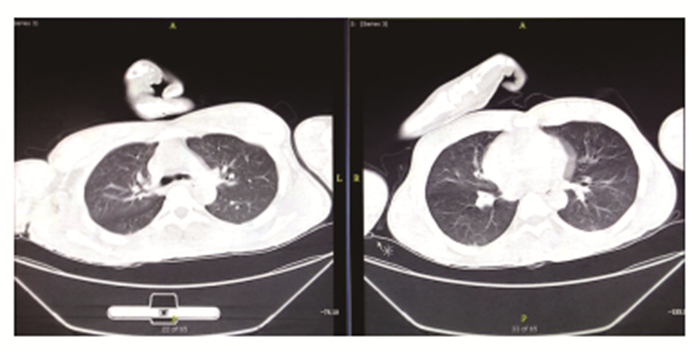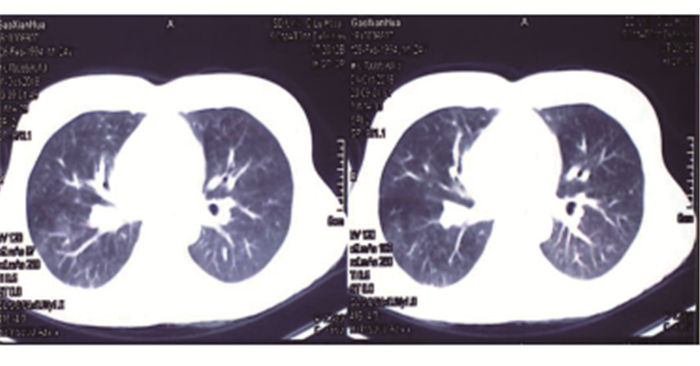2. School of Nursing, Shandong University, Jinan, China
Hydrogen sulfide is a strong nerve poison, which is easy to gather in poorly ventilated environment and enters into human body mainly through the respiratory tract. Fish is rich in sulfur protein. In such hot, unventilated and hypoxic environment as a fish cabin, large number of hydrogen sulfide emitted by decay and metamorphous fish, can cause poisoning.On September 4, 2018, a case of hydrogen sulfide poisoning was admitted to our hospital. The case is described as follows.
Case ReportThe male patient, 24 years old, has been engaged in long-term sea operations. After cleaning the fish cabin with a large number of dead fish on August 6, 2018, he developed consciousness disturbance. After about 10 minutes, he was found by the workers and rescued from the tank.The patient has been in a shallow coma during the treatment in the local hospital. According to his father's description, the patient occured upper limb flexion and cortical ankylosis of lower limb extension during the treatment in the other hospital on August 8, solstice, and muscle paralysis occurred on August 15, 12 solstices, the treatment plan is unknown.Physical examination after admission: temperature 37.2℃, heart rate 88 times/min, respiration 14 times/min, blood pressure 147/86mmhg.Unconsciousness, inresponse to calls, uncooperative in physical examination, large and uniform round pupils on both sides, about 3mm, sensitivity to light reflection, neck rigidity, thick breathing sounds in both lungs, rale of lung was not found, heart rate of 90 beats/min, heart rhythm uniformity, no obvious murmurs in each valve area.The abdomen was flat, the liver can not be touched under the ribs, the muscle tension of the limbs was increased, the muscle strength examination could not be operated and the pathological signs(+).Admission diagnosis: acute hydrogen sulfide gas poisoning, toxic encephalopathy.Laboratory examination results showed that creatine kinase isoenzyme 16.30ng/ml, ALT1087IU/L, AST1470IU/L, AKP707IU/L, TP59g/L, Cr42umol/L, LDH17677IU/L, potassium ion 2.9mmol/L, PH7.49, d-dimer>20ug/ml, FDP>150.00ug/ml, WBC9.83×109/L, and HGB115g/L.After admission, the patient was treated with continuous oxygen inhalation, liver protection, stomach protection, B1, B12 nutritional nerve and other treatment. Laboratory examination on Septembe 6, 2018, showed that white blood cells were 16.64×109/L, neutrophil proportion was 71.40%, FIB1.65g/L, tt-s19.60 s, d-dime 8.72ug/L, ALT775IU/L, AST672IU/L, AKP562IU/L, tp61.0g /L, Cr50umol/L, LDH3797IU/L.Ecg examination showed right bundle branch block.Brain MRI showed abnormal signals in bilateral basal ganglia area, consistent with changes after poisoning, and abnormal signals in bilateral frontotemporal occipital cortex and bilateral frontal white matter area, which were considered as ischemic changes (figure 1). On Septembe 7, 2018, plus treatment with Low molecular weight heparin sodium, salvia miltiorrhizapolyphenols.The patient had a sudden onset of high fever with a body temperature of 38.5℃, and the body temperature dropped to 37.4℃ after the anti-infection treatment with ceftriaxone. The plain chest CT scan of Septembe 11, 2018, showed double pneumonia (figure 2). The muscle tension of Septembe 12, 2018 was significantly decreased, the muscle rigidity time was shortened, and the limb extension rigidity went to the brain rigidity.He was then treated with debugging from 9 September to 19 September, and his condition was in remission. Once again, he occured flexion of upper limbs, decorticate rigidity of extended lower limbs, and usually had no seizure, more than muscle rigidity or even opisthotonic when stimulated by sound and light. On October 1, 2018, craniocerebral CT:(figure 3), ischemic changes were better than before, and chest CT indicated that double pneumonia was better than before(figure 4).The index parameter of blood routine, examination, liver and kidney function, coagulation and other four items were not significantly abnormal, salvia miltiorrhiza polyphenols was stopped on the same day.On November 3rd, the patient automatically opened their eyes, sometimes Shouting, no answers. On November 22nd, the patient was discharged from hospital voluntarily. After six months of rehabilitation treatment, he could walk slowly and independently, and his language was rich but unclear. his time-oriented and location-oriented forces were basically accurate.

|
Figure 1 September 6, 2018, MRI of the brain: abnormal signals in bilateral basal ganglia area were consistent with changes after poisoning, and abnormal signals in bilateral frontotemporal occipital cortex and bilateral frontal white matter area were frequently observed, and ischemic changes were considered. |

|
Figure 2 September 11, 2018, Chest CT: exudation shadow in both lungs, considering pneumonia |

|
Figure 3 October 1, 2018, Brain CT: subarachnoid hemorrhage can not be ruled out. In the midline structure, there was no obvious displacement and diffuse cerebral edema. |

|
Figure 4 October 1, 2018, Chest CT: uneven transmittance of both lungs, considering double pneumonia, better than last examination. |
Hydrogen sulfide is a strong neurotoxin, which is easy to gather in environment with poor ventilation and enters into human body mainly through the respiratory tract with strong irritation, cell asphyxiation and central nervous inhibition[1].Fish is rich in sulfur protein. In such hot, unventilated and hypoxic environment as a fish cabin, large number of hydrogen sulfide emitted by decay and metamorphous fish can cause poisoning, when the concentration of toxic gas in the air is above 30 mg/m3, people can occur poisoning accident, when up to 1400 mg/m3, suction in such environment for a few seconds can lead to lighting death[2, 3]. Among them, nervous system dysfunction is the main clinical manifestation of hydrogen sulfide poisoning and one of the main causes of death[4, 5].The patient who has been in a coma for dozens of hours or even days is likely to develop hypoxic encephalopathy or even become vegetative. In this case, after inhaling hydrogen sulfide gas, the patient was in a coma at first, followed by typical central nervous dysfunction. Brain CT showed diffuse cerebral edema, and the increase of alanine aminotransferase, aspartate aminotransferase and other biochemical indicators suggested that hydrogen sulfide gas had caused damage and dysfunction to multiple organs throughout the body.
Currently, there is no specific antidote for hydrogen sulfide poisoning[6, 7].According to the national occupational health standard of the People's Republic of China gbz31-2002 diagnostic standard for occupational acute hydrogen sulfide poisoning, this patient was suffered from occupational severe hydrogen sulfide poisoning.In addition to respiratory and circulatory support, active control of secondary infection, maintenance of water and electrolyte balance, reasonable nutrition support, and protection of important organs in the patient with hydrosulphide toxic encephalopathy, treatment of microcirculation improvement and the application of targeted antibiotics to control infection are also very necessary in the middle and later period[8].
According to WHO data, there are more than 70 occupations exposed to hydrogen sulfide.In recent years, frequent incidents of hydrogen sulfide poisoning have become a serious threat to the lives of occupational workers [9], our department admits and consults more than 10 cases of occupational hydrogen sulfide poisoningpatients every year, lightning death cases occur repeatedly, severe survival patients are disabled.The main causes of this accident include :①Workers do not have the awareness of hazardous environment protection and are not equipped with necessary protective equipment; ②The fish cabin was not thoroughly ventilated before operation, resulting in the accumulation of highly toxic gases such as hydrogen sulfide released by corrupt fish in the cabin; ③Occupational safety training and education are seriously inadequate, and there is no contingency plan for handling emergencies; ④Lack of supervision over hazardous marine operations.Enterprises' and workers 'awareness of safety protection is weak.This incident reminds us once again that we should strengthen the supervision and management of safety production in offshore operations, strengthen safety protection and training in operations, and make contingency plans for various emergencies to prevent acute poisoning and other emergencies.In case of poisoning incident, reasonable and standard treatment should be carried out quickly to save the lives of the patients, improve the cure rate and reduce the disability rate.
| [1] |
Setko NP. Current aspects of mechanisms underlying effects of multi-component natural gas, its toxicityand selectivity[J]. Med Tr Prom Ekol, 1996, 1: 12-16. |
| [2] |
Ikebuchi J, Yamamoto Y, Nishi K, et al. Toxicological findings in a death involving hydrogen sulfide[J]. The Japanese journal of legal medicine, 1993, 47(5): 406-409. |
| [3] |
Beauchamp RO, Bus JS, Popp JA, et al. A critical-review of the literature on hydrogen-sulfide toxicity[J]. Crit Rev Toxicol, 1984, 13(1): 25-97. DOI:10.3109/10408448409029321 |
| [4] |
Park SH, Zhang Y, Hwang JJ. Discolouration of the brain as the only remarkable autopsy finding in hydrogen sulphide poisoning[J]. Forensic SciInt, 2009, 187(1-3): e19-e21. |
| [5] |
Policastro MA, Otten EJ. Case files of the university of cincinnati fellowship in medical toxicology:two patients with acute lethal occupational exposure to hydrogen sulfide[J]. J Med Toxicol, 2007, 3(2): 73-81. DOI:10.1007/BF03160912 |
| [6] |
Haouzi P, SonobeT, Torsell-Tubbs N, et al. In vivo interactions between cobalt or ferric compound and the pools of sulphide in the blood during and after H2S poisoning[J]. ToxicolSci, 2014, 141(2): 493-504. |
| [7] |
Spagnolo Elvira Ventura, Roman Guido, Zuccarello Pietro, et al. Toxicological investigations in a fatal and non-fatal accident due to hydrogen sulphide (H2S) poisoning[J]. Forensic Sci Int, 2019, 300: e4-e8. |
| [8] |
Chenuel B, Sonobe T, Haouzi P. Effects of infusion of human methemoglobin solution following hydrogen sulfide poisoning[J]. Clin Toxicol (Phila), 2015, 53(2): 93-101. DOI:10.3109/15563650.2014.996570 |
| [9] |
Guo Wei, Kan Juntao, Cheng Zeyu, et al. Hydrogen Sulfide as an Endogenous Modulator in Mitochondria and Mitochondria Dysfunction[J]. Oxid Med Cell Longev, 2012, 878052. |
 2019, Vol. 3
2019, Vol. 3

